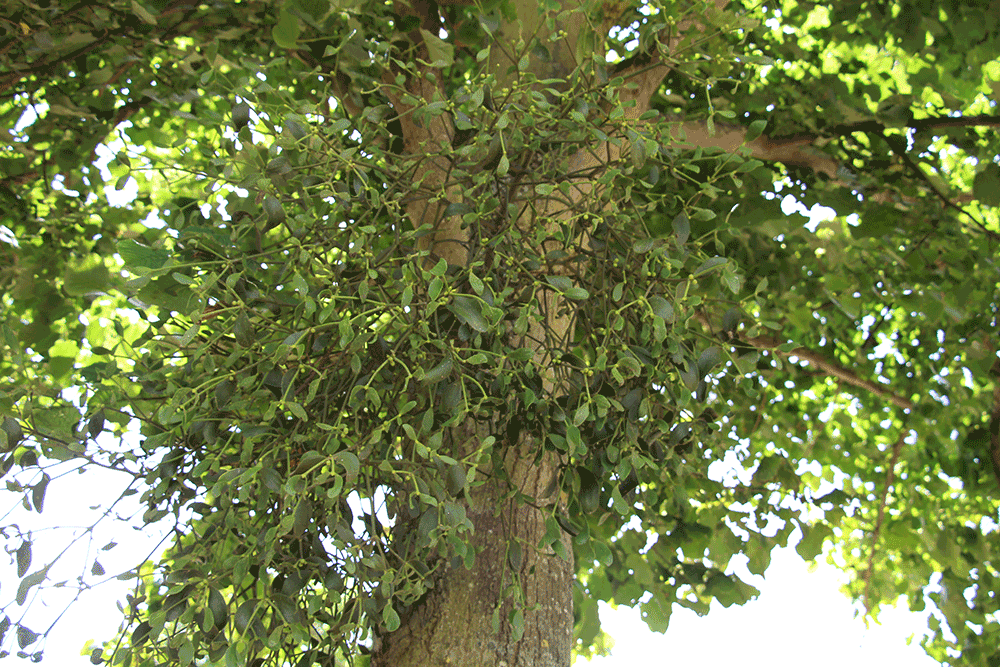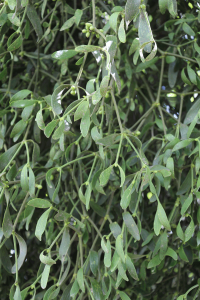Mistletoe has fascinated humans for millennium, many plants have superstitions attached to them but mistletoe seems to have attracted more than most. It’s not hard to understand that a clump of evergreen leaves growing out of dormant tree in midwinter would grab the imagination. The druids are said to particularly venerate mistletoe growing on an oak tree, something it rarely does, harvesting it with a golden scythe on the 6th day after a new moon. Consisting that the plant is woody and gold is an extremely soft metal I not sure how true that is and as they left no written records of themselves this could just be dramatic invention. It still plays an important part in culture with the tradition of kissing under the mistletoe at Christmas but the plant is poisonous with a few berries bring on stomach ache though serious poisoning is rare.
Viscum album is wide spread across Europe and it has over the centuries been seen as a cure of a vast range of ailments right up to the present time. Diokorides (the 1st century AD Greek physician) reported that Hippocrates (in the 4th to 5th century BC) believed mistletoe could be used in the treatment of complaints the spleen and menstruation. Over the following centuries it has been recommended as a treatment for swellings, tumours, epilepsy, infertility and ulcers. In more recent times people have tried to use is to treat hypertension and cancer.
The genus Viscum L. contains about 100 spices but only V. album L. is native the UK and then mainly in the south and midlands. In naming Viscum album L.. Linnaeus took the Latin for mistletoe as the genus and album, no doubt referring to the distinct white berries, for the species name and listed it in volume 2 of his Species Plantarum. The genus Viscum L. is presently in the family Santalaceae along with 6 other genera. The common name Mistletoe comes from the old English mistel and many semi-parasitic plants around the world have the same common name. It is also known as including All-heal and Masslin in England and has many other names across Europe, Germany having a particularly large collection of names for it.
Mistletoe is notoriously difficult to establish and the species is now divided into 3 sub-species depending on the host plant it lives on.
Viscum album subsp. abietis (Wiesb.) Abrom. which grows on Abies species.
Viscum album subsp. austriacum (Wiesb.) Vollm. which grows on pine trees and very rarely on spruce.
Viscum album subsp. platyspermum Kell. (subsp. album) which grows on hard wood trees.
This goes in part towards explaining why it is so difficult to establish mistletoe as the sub-species are very specific to their chosen host but there also appears to be genetic factors as not all potential host can be infected with equal ease. For example, oak is rarely infected but even then there is a wide range of how readily a plant will be infected with a particular oak species. Therefore, where a plant has only a few mistletoe plants on it not become host to a lot and only specimens with a lot of mistletoes will host a lot.
Mistletoe is evergreen with tiny flowers that are insect pollinated and would never be noticed; the insects are attracted by the sweet smell . The male and female flowers are on separate plants with about 4 times as many female plants as male ones. The plants flower between the end of February and April and the fruits (or berries) appear from October to May with Mid-March to mid-May being the best time to sow the seed, making sure to brake the outer coating and allowing the sticky contents to help the seed adhere to the bark of the host tree.
Mistletoe is a parasite, all be it a partial one, taking water and minerals from the host tree and this weakens the tree. Infected apples trees will yield between 7% and 56% less depending on how vigorous the rootstock is, with the plants growing on the more vigorous rootstocks affected the least. Once established the Mistletoe shoot doesn’t divide for the first 3 or 4 years then each year the shoot divides in two, ultimately reaching about 1 metre across, so giving a very rough and ready guide to its age.




